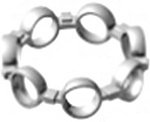The ball bearing cage (also known as a ball bearing retainer or ball separator – these are used interchangeably), is the component in a ball bearing that separates the balls, maintains the balls’ symmetrical radial spacing and in most cases holds the bearings together.

Cages can also be utilized in providing lubrication by acting as a reservoir for oils, or by supplying a solid film via the cage material itself or a coating on the cage. The designer’s selection of the appropriate cage for the application is essential in achieving the desired life and performance of the bearing.
As with any bearing part, the cage has its own set of terminology which can be esoteric to those not working with them on a regular basis. Here are a handful of important terms in the area:
Tabs: For two-piece steel ribbon retainers, tabs (AKA ears) are the protrusions on the male half of a ribbon retainer that is clinched over the female half to hold them together.
Ball Pocket: The part of the retainer that surrounds and positions the ball. The diametrical clearance between the ball and the ball pockets can be as small as 0.0035” in miniature and instrument bearings and can be upwards of 0.010” in larger bearings. Properly designed retainers will have the ball touch the ball pocket exactly on the pitch circle of the balls. Should contact be made above or below the pitch circle, you could statically experience retainer hang-up and dynamically experience running torque spikes.
Slot: For crown type retainers, the slot is the opening that the ball passes through (during bearing assembly) prior to entering the ball pocket.
Coined ball pocket: In metallic crown ball bearing retainers, an oversized ball is drawn through the blank ball pocket to form a spherical surface for the balls to contact. The retainer is then hardened so it can be snapped into the bearing without permanently deforming the tabs/ears.
Loose Clinch: Ribbon retainers should be loosely clinched so that the balls can orient the two retainer halves. The loose clinch (AKA Crimp) provides for less noise as well as lower runner and starting torque.
And as always, AST’s team of bearing experts are ready to lend their expertise, contact them here with questions.

